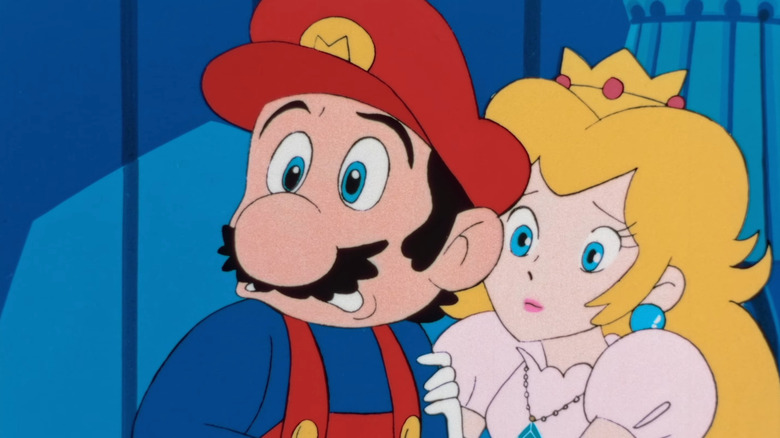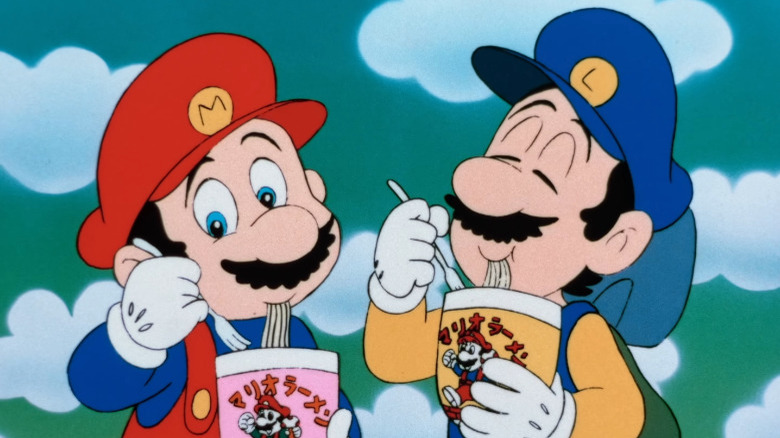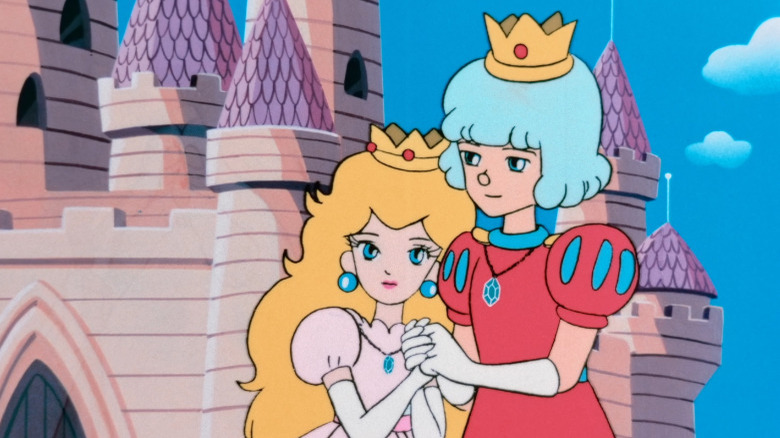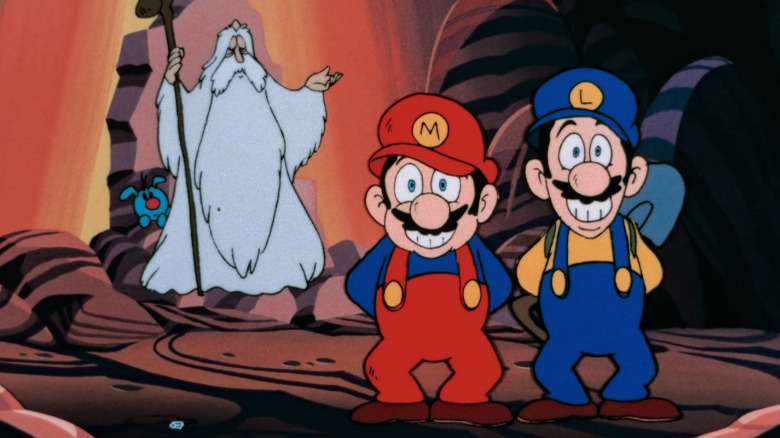The First, Forgotten Mario Bros. Movie Introduced The Worst Mario Character Ever
Pop quiz, film lovers: What was the first feature-length movie based on a video game?
Conventional wisdom tells you that the answer is 1993's "Super Mario Bros.", a live-action, extremely loose (and very underrated) adaptation of the beloved Nintendo video game series about a pair of plumbers who travel to another world and rescue a princess from an evil reptile man. But conventional wisdom isn't necessarily the same thing as actual wisdom, because the real answer is more complicated.
The first feature-length film adapted from a video game was actually a tie between the anime films "Running Boy: Star Soldier's Secret" and "Super Mario Bros.: The Great Mission to Rescue Princess Peach!" Both movies came out on July 20, 1986, and both films have lapsed into near total obscurity, thanks to the fact that they were barely released in the first place. It doesn't help that they have never been officially translated into English.
The "Super Mario Bros." anime is a strange beast, both adapting the original video game and making huge changes. Some of those changes wound up making their way into the official Mario canon, even though most people have no idea they originated in an anime movie, and others were super weird alterations that don't seem to have been ever referenced again ... like the introduction of a character who is probably the worst in the history of this whole series.
'It's ani-me, Mario!'
"Super Mario Bros.: The Great Mission to Rescue Princess Peach!" begins with Mario playing video games in the middle of the night, when suddenly Princess Peach jumps out of the television, followed by King Koopa, aka Bowser. Mario can't defend her and she gets whisked away by Bowser, leaving behind a mysterious necklace. The next day, while Mario and Luigi work at the grocery store they own (instead of being plumbers), a strange blue dog steals the necklace and leads them to the Mushroom Kingdom.
There, they discover that they are destined to rescue Princess Peach from King Koopa by collecting three magical items: a mushroom, a flower, and a star. So begins their epic quest, with the dog by their side, through various misadventures. They eat a lot of mushrooms and trip out. They get distracted by a gold mine and get trapped. They find a magic flying boat underwater and traverse all the way to King Koopa's castle, where they eat the power-ups and rescue Princess Peach before the villainous turtle can force her to marry him.
After the final fight, Peach kisses Mario and thanks him for his help. He returns the necklace and Peach explains that she's destined to marry whoever has the exact same necklace. Mario turns to Luigi and asks if they have a necklace just like it in their shop. Luigi says no, and then the dog suddenly transforms into a guy named Prince Haru and says he had the other necklace the whole time so now he's going to marry Princess Peach. That's how the story ends. Mario and Luigi go home. Also, King Koopa now works at their grocery store.
Prince u been go-o-o-o-ne
If you're wondering who Prince Haru is and why you haven't seen him in literally any other Mario media, it's because this seems to be the only time he's ever appeared in the Super Mario canon. It's also because he sucks.
And it's not because Peach is supposed to end up with Mario. Come to think of it, it's hard to say exactly what Mario's relationship with Princess Peach is. It's sometimes portrayed as innocently romantic, but at the end of "Super Mario Bros. Galaxy" he clearly declares his intentions and she rejects him right along with Bowser. They're clearly friends, maybe good friends, maybe even flirty friends, but they've had decades to form a meaningful relationship — with or without marriage — and it's never happened.
And that's the point. Peach is an independent person. She runs a kingdom all by herself, and she go-karts and smashes bros with the best of them. To suddenly give her a love interest who she's never met but absolutely has to marry — and making her 100 percent happy with this — is a deus ex machina, and not even an amusing one. Prince Haru's existence is dramatically dissatisfying and Peach's response to him does a disservice to her character.
The effect of anime on many the modes of Marios
"Super Mario Bros.: The Great Mission to Rescue Princess Peach!" has a shoddy ending and some of the changes it makes to the Mario story are simply weird and arbitrary. Luigi's outfit is yellow and blue, instead of green and blue. It's hard to imagine what the point of changing their profession from plumbers to grocers was. Why does Mario suddenly dress up like Pancho Villa and shoot guns into the air? Why is King Koopa a shape-shifter now? Was the underwater glam rock scene really necessary?
But it sure is interesting to watch "Super Mario Bros.: The Great Mission to Rescue Princess Peach!" and realize that some of the creative decisions, which probably seemed strange in 1986, wound up becoming an official part of the canon. For what seems to be the first time, Luigi was drawn taller and skinnier than Mario. For the first time, there's a flying wooden ship. For the first time, Mario picks up Bowser by the tail, swings him around, and throws him. Heck, this movie seems to be the first time it's explicitly stated that Bowser kidnapped Princess Peach because he wanted to marry her.
It's not uncommon, though rarely discussed, for ancillary media to create new iconography that becomes official canon later. Batman didn't originally have a Batcave in the comics. That was invented for the live-action movie serial in 1943. Kryptonite didn't make its first appearance in a Superman story until the radio series "The Adventures of Superman," also in 1943. It doesn't matter where good ideas originate. If they're good ideas they usually stick around.
This explains why nobody's seen or heard from Prince Haru since 1986.



